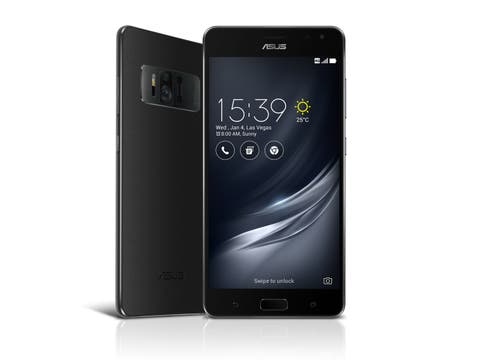Asus isn’t very good at keeping secrets, but this thing is so beastly it doesn’t really matter to us. The brand new Asus Zenfone AR is the latest Project Tango device, with specs far above your typical device. So, let’s take a closer look at the brand new Zenfone AR.
First off, Asus really wants you to know that the Zenfone AR is Project Tango device. It’s designed around machine vision with a camera and sensor setup that provides motion tracking, depth perception, and area learning.
It achieves this its TriCam system, made up of a 23-megapixel rear camera, a motion-tracking camera, and an infrared camera, all on the back of the device. These sensors also help when using Daydream, Google’s own VR solution after Cardboard’s success.
“So what can I do with this fancy Project Tango setup,” I hear you ask. Well, Asus showed off Tango’s abilities with an app by GAP which allowed them to sort through different clothing articles. While that’s not really impressive, they could also compare sizes by placing said clothing on mannequins and walking around. That’s pretty nifty.
Then there’s the Hot Wheels app they demoed that lets you interact with virtual toy car tracks, either ones you create yourself or pre-made challenges. Typically, you’d just use onscreen controls, but with the Zenfone AR you can just move the device to place tracks. Not the most riveting of uses, but it shows that there’s potential for the technology if used right.
Speaking of the camera, the ZenFone AR sports a 23-megapixel Sony IMX318 camera. It comes a ‘TriTech+ autofocus system’, dual-PDAF, laser focus, and continuous-focus. The rear camera also supports 4-axis OIS (ala Xiaomi Mi5) as well as 3-axis EIS for 4K video recording.
As for the other specs, the Zenfone still features the Snapdragon 821 instead of the 835. This isn’t optimal, but Asus makes up for it with a monstrous 8GB of RAM (Yes, you saw that right). There’s also 5.7-inch WQHD (2,560 x 1,440 pixels, for Daydream) Super AMOLED screen, and a powerful five-magnet speaker system.
It also includes a ‘Vapor Cooling’ system to ensure that your smartphone doesn’t heat up even with heavy AR and VR apps. Though I have no idea how that works (or if it’ll actually work at all), it’s a nifty sounding feature.
On the software front, it runs on Android 7.0 Nougat wrapped under Asus ZenUI on top. The smartphone also features a fingerprint sensor embedded inside the home button on front. Other details such as battery capacity, pricing and front camera have yet to be announced.

Pretty beef up. I have a feeling this is going to be in the $700 ish.
I am hoping it wont be more than $500. I could purchase this by next month if its not more than that.
It probably won’t though since it’s Asus. Just go for the OP3 T if that’s your budget. You won’t regret it.
I could stretch it to $600 or maybe $650. But not above that. I really love the phone’s features.
But like you said, I think I will have to go with the OP3T. Asus will not take it easy on the price front.
OP3 T still beats majority if not all the phones out there now at a lower cost without sacrificing the premium feel. OP development support is the best after Google phones. I have the OP3 now. Zero regrets, in fact I’m thinking weather if OP3 T is worth the upgrade from OP3.
Does the OP3T have a, IR blaster? I really need this feature.
They don’t tho. It’s a rather obsolete tech. do you really need it? If you still do then maybe, Xiaomi Mi5s Plus is good option (Mi Note 2 for better cam but more expensive). The development is still in early stages but learning from history, It’ll come around. or LeEco Le Pro3 but some users are experiencing problems with the touch on the upper corner of the screens. LeEco had acknowledged the bug and will fix it on the next update. Nonetheless OP3 is better tho, in my opinion.
With Project Tango camera unit and latest Snapdragon Soc, it’s going to be over $1000USD.